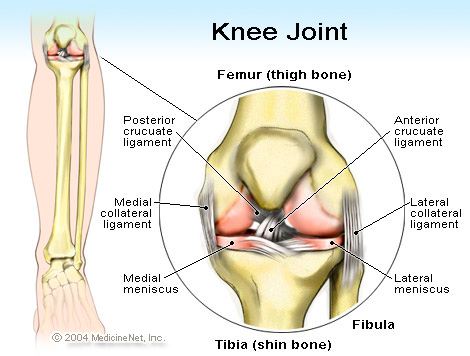Here is a discussion about the anatomy of your knee and common ailments we treat at River Ridge Chiropractic. You may have recently been diagnosed with one of these conditions, or are even wondering what is causing you knee pain. Most of these conditions can be treated naturally with effective results. Our office is familiar with all of these and can offer a variety of possible solutions.
KNEE ANATOMY
(adapted from Big Knee Pain)
Bones:
The bones connected to the knee include the femur (thigh bone), tibia (shin bone), patella (knee cap), and fibula (smaller bone next to shin bone). Muscles, tendons and ligaments connect the knee bones. The kneecap glides in a groove in the thigh bone and adds leverage to the thigh muscles, which are used to extend the leg. The thigh bone and shine bone come together at the knee joint and move on one another when bending or straightening the leg.
Knee joint capsule:
The knee joint capsule is a sac that encloses the knee joint cavity. It is attached to the bones of the joint, and forms the joint cavity. The knee joint capsule has a tough, fibrous outer membrane and an inner synovial membrane, which produces joint fluid (synovial fluid) that lubricates the joint and nourishes the articular cartilage that coats the ends of the bones in the joint.
Knee ligaments:
Two ligaments are in the center of knee and are bathed in joint fluid – the anterior cruciate ligament (ACL) and the posterior cruciate ligament (PCL)
The other two ligaments are located on the outside of the knee joint – the medial collateral ligament (MCL) on the inner side and the lateral collateral ligament (LCL) on the outer side.
Ligaments on the outside of kneecap usually heal by themselves. Ligaments in the center of the knee rarely heal on their own because they are bathed in joint fluid and lack blood supply.
Knee cartilage:
- Articular Cartilage: The back surface of kneecap, end of femur, and top of tibia are all covered with articular cartilage. Damage to the articular cartilage is usually diffuse damage. This is usually gradual “wear and tear” damage caused by overuse, aging, and can be accelerated by poor knee tracking.
- Meniscal Cartilage: This is a spongy shock absorber and is usually the cartilage referred to when you hear “torn cartilage.” The meniscus is commonly torn in twisting injuries.
Knee Muscles:
- Quadriceps: Muscles on the front of the thigh. Used to straighten the knee
- Hamstrings: Muscles on the back of thigh attach to tibia (shin bone) at back of knee. Used to bend the knee.
Knee Tendons:
Tendons join muscle to bone. The quadriceps tendon hooks quad muscles to the patella (kneecap); patella tendon connects the patella to the shinbone. The quadriceps tendon and patellar tendon actually connect to form one continuous tendon that covers the patella.
Bursae: Small sacs that provide a lubricating surface between surfaces that needs to move
Common knee issues include arthritis, ligament injuries, cartilage injuries, patellar tendonitis (tendonitis involving the large tendon over the front of the knee), chondromalacia patella (softening of cartilage), dislocation, baker’s cyst (swelling in the back of the joint), bursitis (commonly just above the kneecap), plica syndrome (uncommon cause), Osgood-Schlatter Disease (irritation of the growth plate), osteochondritis dissecans (a condition due to the growth of bone around the joint), and gout.
If you are experiencing knee pain or discomfort and are ready to book an appointment, I will be happy to work with you to figure out the best care pathway for your individual needs.
We also have more blog posts about knee pain for further reading.

